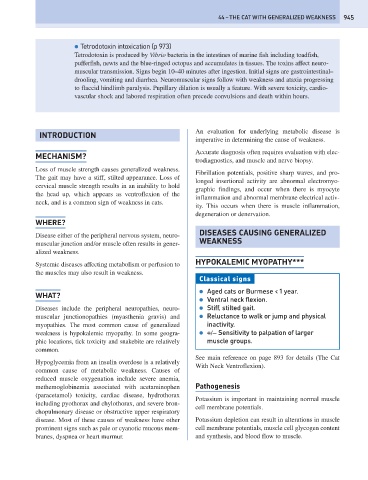Page 953 - Problem-Based Feline Medicine
P. 953
44 – THE CAT WITH GENERALIZED WEAKNESS 945
● Tetrodotoxin intoxication (p 973)
Tetrodotoxin is produced by Vibrio bacteria in the intestines of marine fish including toadfish,
pufferfish, newts and the blue-ringed octopus and accumulates in tissues. The toxins affect neuro-
muscular transmission. Signs begin 10–40 minutes after ingestion. Initial signs are gastrointestinal–
drooling, vomiting and diarrhea. Neuromuscular signs follow with weakness and ataxia progressing
to flaccid hindlimb paralysis. Pupillary dilation is usually a feature. With severe toxicity, cardio-
vascular shock and labored respiration often precede convulsions and death within hours.
An evaluation for underlying metabolic disease is
INTRODUCTION
imperative in determining the cause of weakness.
Accurate diagnosis often requires evaluation with elec-
MECHANISM?
trodiagnostics, and muscle and nerve biopsy.
Loss of muscle strength causes generalized weakness.
Fibrillation potentials, positive sharp waves, and pro-
The gait may have a stiff, stilted appearance. Loss of
longed insertional activity are abnormal electromyo-
cervical muscle strength results in an inability to hold
graphic findings, and occur when there is myocyte
the head up, which appears as ventroflexion of the
inflammation and abnormal membrane electrical activ-
neck, and is a common sign of weakness in cats.
ity. This occurs when there is muscle inflammation,
degeneration or denervation.
WHERE?
DISEASES CAUSING GENERALIZED
Disease either of the peripheral nervous system, neuro-
muscular junction and/or muscle often results in gener- WEAKNESS
alized weakness.
Systemic diseases affecting metabolism or perfusion to HYPOKALEMIC MYOPATHY***
the muscles may also result in weakness.
Classical signs
● Aged cats or Burmese < 1 year.
WHAT?
● Ventral neck flexion.
Diseases include the peripheral neuropathies, neuro- ● Stiff, stilted gait.
muscular junctionopathies (myasthenia gravis) and ● Reluctance to walk or jump and physical
myopathies. The most common cause of generalized inactivity.
weakness is hypokalemic myopathy. In some geogra- ● +/- Sensitivity to palpation of larger
phic locations, tick toxicity and snakebite are relatively muscle groups.
common.
See main reference on page 893 for details (The Cat
Hypoglycemia from an insulin overdose is a relatively
With Neck Ventroflexion).
common cause of metabolic weakness. Causes of
reduced muscle oxygenation include severe anemia,
methemoglobinemia associated with acetaminophen Pathogenesis
(paracetamol) toxicity, cardiac disease, hydrothorax
Potassium is important in maintaining normal muscle
including pyothorax and chylothorax, and severe bron-
cell membrane potentials.
chopulmonary disease or obstructive upper respiratory
disease. Most of these causes of weakness have other Potassium depletion can result in alterations in muscle
prominent signs such as pale or cyanotic mucous mem- cell membrane potentials, muscle cell glycogen content
branes, dyspnea or heart murmur. and synthesis, and blood flow to muscle.

